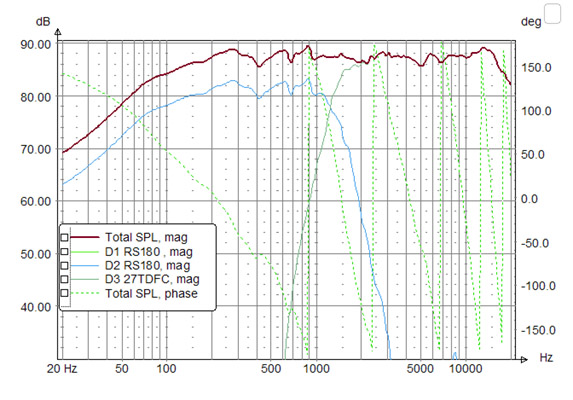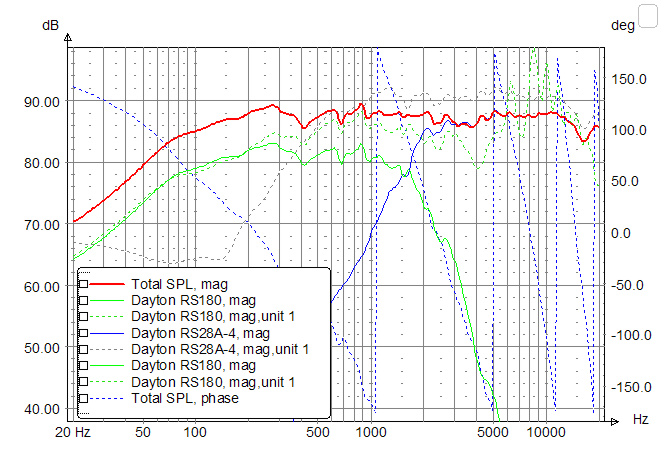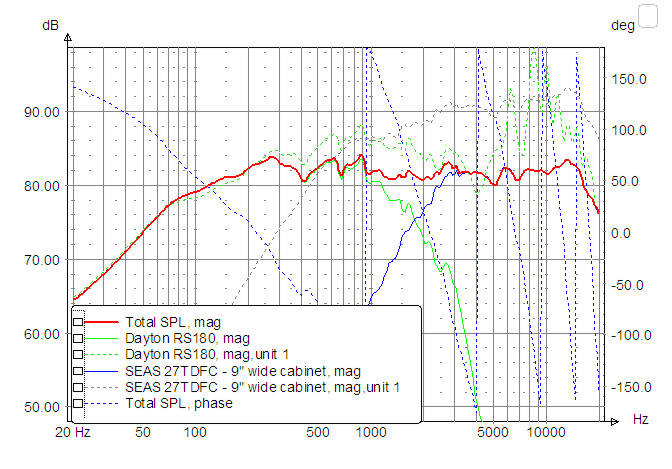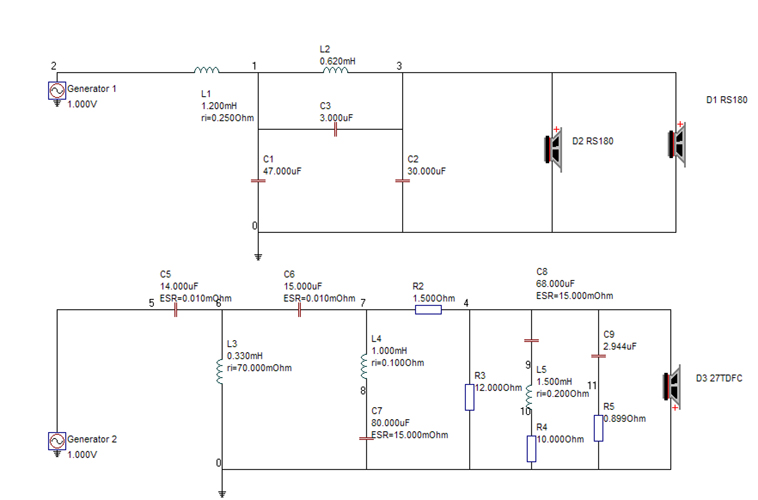This thread is rapidly abandoning all other issues of "designing a 2-way bookshelf speaker" and focusing on the headache of managing metal-cone midbass units, it appears.

Anyway, the saga continues.
I walked over to htguide.com and looked once again at the other designs done by Jon Marsh, other than his fastidious Modula MTM. There was the Natalie P MTM and the Modula MT, all with the same Dayton RS midbass drivers. All these designs are apparently very well received.
The
Natalie P SPL curve looks something like this, as published:
We can see down till about 45dB below base SPL, but can't see below this. So, looking at the green midbass curve here, we know that the resonant peaks have been cut by at least about 40dB (flat portion at about 80dB, bottom of the graph is about 40dB) but we don't know whether they've been cut by 60dB, which I had set as a personal minimum target. Even a cut of 40dB is actually excellent, if compared to all those dozens of DIY attempts using LR4 at 2.5KHz with similar drivers.
I then looked at the
RS 180 Modula MT curves. This is a design done to a tighter budget, trying to get as much out of the excellent drivers as possible.
Here we are able to see only about 35dB below the base SPL, so we don't know whether the resonant peaks are at -37dB or at -60dB. Till I can see that, I can't quite figure out how effective these midbass filters have been.
One option, of course, would be to pick up Jon Marsh' FRD and ZMA files, put them into a crossover model replicating his design, and see for myself. Jon has often shared his FRD / ZMA files with others -- he's a fabulous guide and mentor that way.
So, I went further afield and looked at one of the most famous DIY designs using expensive metal-cone midbass units: the glamorous
Seas Thor kit, which retails for USD 1,900 for a stereo set of drivers and crossovers. This design is by the Great Jo D'Appolito, and needless to say, they are an MTM design. There have been criticisms of his crossover design, and I believe there are many attempts on diyaudio.com to re-design a better crossover with the same enclosure and drivers.
Here's the raw SPL of the very expensive Seas Excel W18 midbass, from their datasheet:
Nothing surprising here: it's as nasty as any other high-end metal-cone midbass unit. That peak at about 4.8K or so is one of the ugliest in the industry.
This is the only information you get from Seas about the resulting crossover SPL:
I was stumped to see that the curves of the individual drivers were missing. Looking at a summed SPL curve does not tell you anything about how much coloration is being added by individual drivers 20-30dB below the base line. And with metal-cone drivers, if I don't have that data, I have absolutely no idea how effective the crossover has been. In short, this summed graph is for lay buyers who want to trust the big brand and high price.
So, in frustration I looked at the crossover diagram for more details:
and I couldn't believe my eyes. The midbass crossover is using a simple first-order electrical low-pass (L1), plus a notch (L2/C1/R1). I have very little doubt that the 5K-and-above range has not been cut sufficiently at all. I cannot believe how anyone who knows anything about crossover design will accept this crossover. We are all certain that Dr D'Appolito knows a lot about speaker design -- I suspect he agreed to this crossover due to budget constraints.
This is the kind of design, with fundamental flaws, which get the subjectivist camp of audiophiles all excited. They start tweaking all sorts of things, from capacitor brands to inductor brands to silver-plated internal wirings. Needless to say, some of these things will make audible changes, and some changes will be "better sounding" than others. But none of these changes will make a "flawed" speaker "good". Fundamental flaws must be fixed where they stand, not by changing their surroundings.
I remember one comment from a friend when I was prototyping my very first Asawari a decade back. I found the sound harsh and edgy. My friend said "replace all your white-coffin resistors with non-inductive Mills resistors -- Mills resistors sound very smooth. I can guarantee that this will fix it." Luckily, I had less money and more brains. I stared at the SPL curves, saw that there was a 1-1.5dB hump in the tweeter response, cut that down by tweaking the shunt resistors, and the harshness was gone. My friend has remained my very dear friend, but we have differences in perspective.
We have all heard comments like
"This speaker is good for vocals and jazz, but sounds too bright for hard rock", or
"That model is superb for hard rock, but soft vocals sound lacking in detail." These remarks are attempts by frustrated listeners to justify
flawed designs. Other than bass response, two speakers should aim to sound identical, if
flaws are removed. I don't understand what some designers claim to do by "voicing" their designs, other than "voicing" for bass (which has a lot of room dependence and needs careful tuning for optimal performance). In the mids and highs, how can two voicings be both correct? The job of a speaker, IMHO, is
accurate reproduction, not "voiced" reproduction. No one will buy a fountain pen if its designer says
"This pen is good for writing romantic poetry; we have another model for writing scientific papers." I would laugh at such a remark. I am sometimes afraid that some of my subjectivist audiophile friends would nod sagely and agree with the designer. As you can guess, I don't have too many audiophile friends.

The only reasons why speaker designers may tolerate flaws in their speakers are:
(i) material science and mechanical engineering hasn't reached the level needed to eliminate fundamental flaws, e.g. cone breakup, and
(ii) budget constraints which prevent designing large/complex (i.e. expensive) crossovers or enclosures. These are understandable reasons. But a lot of designs are flawed even before hitting these limits, IMHO. In particular, DIYers sometimes spend money on $300 individual drivers and and then use stupid crossovers. It's very interesting to read all those comments on htguide.com from readers who have criticised Jon Marsh for the high parts cost of his Modula MTM crossover. These same readers will usually have absolutely no comment if someone builds a Seas Thor, which now appears to be a silly and overpriced design. If I had to bet, I'll bet $1,000 of my hard-earned money that the Modula MTM in a good enclosure will perform better overall than the Seas Thor.
I have now "copied" Jon Marsh' CE crossover (from
the Modula MTM) into my modeling software and am trying to see if I can tweak it to fit other drivers. Once I learn to tweak a CE crossover, I'll be able to tackle any projects which involve this class of drivers, and I am 100% certain that any Thor built with such a crossover will beat the original design by miles. This is what the original looks like:
Wish me luck. :lol: The next post, whenever it happens, will document what I have been able to do, with Angshu's help, about taming the CE filter.
Edit:
Interestingly, my poking around in old threads found a lot of concern on other forums about the Thor crossover. I found
one thread on htguide.com which resulted in a redesign of the entire crossover.
The new xo topology
(see here) has a much higher parts count than the original one, and the SPL curves
(this post) clearly show how steeply the midbass output is being cut and how well the resonant peak region is being suppressed. The designer has cut the 4.8KHz peak by about 60dB. He's used a CE low-pass for the midbass and what appears to be a 4th order electric on the tweeter. He's also shifted the Fc down to a lower frequency (shift by almost 1KHz, in fact, IIRC) to give his midbass low-pass more space to suppress the 4KHz and higher regions.
These went to confirm my fears that I'm not barking up a fantasy tree -- these are genuine areas of concern.








